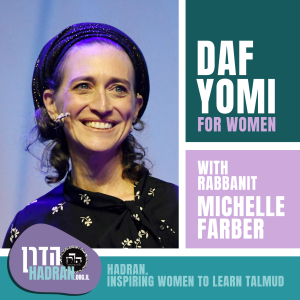
Study Guide Chagigah 3
Today’s daf is sponsored by Tracy Akner for a refuah shleima for Shifra Hadassah bat Chana and Shimon ben Tziporah.
The Gemara establishes that one who can hear but not speak and one who can speak but not hear is exempt from the mitzva of “seeing” – coming to the Temple and bringing holiday burnt offerings but obligated in the chagigah sacrifices. This exemption is derived by a gezeira shava from verses of Hakhel. How do we know that this person is also exempt from Hakhel? Rabbi Tanchum mentions other people who are exempt as well – one who is deaf in one ear, one who has one leg. Where are these derived from? A story is told (including within it a drasha about Hakhel) of rabbis who went to visit their rabbi, Rabbi Yehoshua, on the holiday and he wanted to know what drashot they heard in the Beit Midrash. At first, they are hesitant to say but after much coaxing, they tell him what they learned from Rabbi Elazar ben Azaria. The first drasha is why the children were also brought to Hakhel. The second drasha explains the unique 2-way relationship between God and the Jewish people. The third is an explanation of the verse in Kohelet 12:11 that compares the words of the rabbis to prodders and to nails. There is a beautiful description of the importance and beauty of learning Torah. The end of the verse refers to the multitude of different opinions among the rabbis. If that is the case, what is our job as a learner – how to make sense of it all? Why were those rabbis so hesitant to tell Rabbi Yehoshua the drashot they hear din the Beit Midrash? Their fear was due to a different story where someone was in a similar situation – went to visit Rabbi Eliezer - and after sharing what had happened in the Beit Midrash, Rabbi Eliezer prays that he be blinded and he is. Why?? The story ends with his vision restored. The Gemara goes back to analyzing the Mishna and asks how can we determine when someone is considered a shoteh and is exempt as well?
More Episodes
 2024-01-10
2024-01-10
 2024-01-09
2024-01-09
 2024-01-08
2024-01-08
 2024-01-07
2024-01-07
 2024-01-05
2024-01-05
 2024-01-05
2024-01-05
 2024-01-04
2024-01-04
 2024-01-03
2024-01-03
 2024-01-02
2024-01-02
 2024-01-01
2024-01-01
 2023-12-31
2023-12-31
 2023-12-29
2023-12-29
 2023-12-28
2023-12-28
 2023-12-27
2023-12-27
 2023-12-26
2023-12-26
 2023-12-25
2023-12-25
 2023-12-24
2023-12-24
 2023-12-22
2023-12-22
Create your
podcast in
minutes
- Full-featured podcast site
- Unlimited storage and bandwidth
- Comprehensive podcast stats
- Distribute to Apple Podcasts, Spotify, and more
- Make money with your podcast
It is Free
- Privacy Policy
- Cookie Policy
- Terms of Use
- Consent Preferences
- Copyright © 2015-2024 Podbean.com





